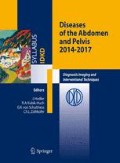Abstract
[18F]-fluorodeoxyglucose (FDG)-positron emission tomography/computed tomography (PET/CT) is considered the standard imaging modality in Hodgkin’s disease and aggressive non-Hodgkin’s lymphoma. In the European Society of Medical Oncology guidelines, FDGPET/CT is strongly recommended for staging and restaging Hodgkin’s disease and diffuse large B-cell lymphoma
Access this chapter
Tax calculation will be finalised at checkout
Purchases are for personal use only
References
Hutchings M, Loft A, Hansen M et al (2006) Positron emission tomography with or without computed tomography in the primary staging of Hodgkin’s lymphoma. Haematologica 91:482–489.
Pelosi E, Pregno P, Penna D et al (2008) Role of whole body [18F] fluorodeoxyglucose positron emission tomography/computed tomography (FDG-PET/CT) and conventional techniques in the staging of patients with Hodgkin and aggressive non-Hodgkin lymphoma. Radiol Med 113:578–590.
Bangerter M, Moog F, Buchmann I et al (1998) Whole-body 2-[18F]-fluoro-2-deoxy-D-glucose positron emission tomography (FDG-PET) for accurate staging of Hodgkin’s disease. Ann Oncol 9:1117–1122.
Rigacci L, Vitolo U, Nassi L et al (2007) Positron emission tomography in the staging of patients with Hodgkin’s lymphoma: a prospective multicentric study by the Intergruppo Italiano Linfomi. Ann Hematol 86:897–903.
Shipp MA, Harrington DP, Anderson JR et al (1993) Development of a predictive model for aggressive lymphoma: The International Non-Hodgkin’s Lymphoma Prognostic Factors Project. N Engl J Med 329:987–994.
Hasenclever D, Diehl V (1998) A prognostic score for advanced Hodgkin’s disease: International Prognostic Factors Project on advanced Hodgkin’s disease. N Engl J Med 339:1506–1514.
Spaepen K, Stroobants S, Dupont P et al (2002) Early restaging positron emission tomography with 18F-fluorodeoxyglucose predicts outcome in patients with aggressive non-Hodgkin’s lymphoma. Ann Oncol 13:1356–1363.
Haioun C, Itti E, Rahmouni A et al (2005) [18F]fluoro-2-deoxy-D-glucose positron emission tomography (FDG-PET) in aggressive lymphoma: an early prognostic tool for predicting patient outcome. Blood 106:1376–1381.
Mikhaeel NG, Hutchings M, Fields PA et al (2005) FDG-PET after two to three cycles of chemotherapy predicts progression-free and overall survival in highgrade non-Hodgkin lymphoma. Ann Oncol 16:1514–1523.
Safar V, Dupuis J, Jardin F et al (2009) Early 18 fluourodeoxyglucose PET scan as a prognostic tool in diffuse large B-cell lymphoma patients treated with an anthracycline-based chemotherapy plus rituximab. Blood 114:45.
Cashen A, Dehdashti F, Luo J et al (2008) Poor predictive value of FDG-PET/CT performed after 2 cycles of R-CHOP in patients with diffuse large B-cell lymphoma (DLCL). Blood 112:144.
Gallamini A, Hutchings M, Rigacci L et al (2007) Early interim 2-[18F]fluoro-2-D-glucose positron emission tomography is prognostically superior to international prognostic score in advanced stage Hodgkin’s lymphoma: a report from a joint Italian-Danish study. J Clin Oncol 25:3746–3752.
Cerci JJ, Pracchia LF, Linardi CCG et al (2010) 18F-FDG PET after 2 cycles of ABVD predicts eventfree survival in early and advanced Hodgkin lymphoma. J Nucl Med 51:1337–1343.
Spaepen K, Stroobants S, Dupont P et al (2001) Prognostic value of positron emission tomography (PET) with fluorine-18 fluorodeoxyglucose ([18F]FDG) after first-line chemotherapy in non-Hodgkin’s lymphoma: is [18F]FDG-PET a valid alternative to conventional diagnostic methods? J Clin Oncol 19:414–419.
Engert A, Kobe C, Markova J et al (2010) Assessment of residual bulky tumor using FDG-PET in patients with advanced-stage Hodgkin lymphoma after completion of chemotherapy: final report of the GHSG HD15 trial. Blood 116:336.
Cerci JJ, Trindade E, Pracchia LF et al (2010) Cost effectiveness of positron emission tomography in patients with Hodgkin’s lymphoma in unconfirmed complete remission or partial remission after firstline therapy. J Clin Oncol 28:1415–1421.
Zinzani PL, Stefoni V, Tani M et al (2009) The role of FDGPET scan in the follow-up of lymphoma: experience on 421 patients. J Clin Oncol 27:1781–1787.
Petrausch U, Samaras P, Haile SR et al (2010) Risk-adapted FDG-PET/CT-based follow-up in patients with diffuse large Bcell lymphoma after firstline therapy. Ann Oncol 21:1694–1698.
Petrausch U, Samaras P, Veit-Haibach P et al (2010) Hodgkin’s lymphoma in remission afer first-line therapy: which patients need FDG-PET/CT for follow-up? Ann Oncol 21:1053–1057.
Spaepen K, Stroobants S, Dupont P et al (2003) Prognostic value of pretransplantation positron emission tomography using fluorine 18-fluorodeoxyglucose in patients with aggressive lymphoma treated with high-dose chemotherapy and stem cell transplantation. Blood 102:53–59.
Lambert JR, Bomanji JB, Peggs KS et al (2010) Prognostic role of PET scanning before and after reduced-intensity allogeneic stem cell transplantation for lymphoma. Blood 115:2763–2768.
Lin C, Itti E, Haioun C et al (2007) Early 18F-FDG PET for prediction of prognosis in patients with diffuse large B-cell lymphoma: SUV-based assessment versus visual analysis. J Nucl Med 48:1626–1632.
Cheson BD, Horning SJ, Coiffier B et al (1999) Report of an International Workshop to standardize response criteria for non-Hodgkin’s lymphomas. J Clin Oncol 17:1244–1253.
Cheson BD, Pfistner B, Juweid ME et al (2007) Revised response criteria for malignant lymphoma. J Clin Oncol 25:579–586.
Dupuis J, Itti E, Rahmouni A et al (2009) Response assessment after an inductive CHOP or CHOP-like regimen with or without rituximab in 103 patients with diffuse large B-cell lymphoma: integrating 18fluorodeoxyglucose positron emission tomography to the International Workshop Criteria. Ann Oncol 20:503–507.
Author information
Authors and Affiliations
Editor information
Editors and Affiliations
Rights and permissions
Copyright information
© 2014 Springer-Verlag Italia
About this chapter
Cite this chapter
Schaefer, N.G. (2014). Lymphoma: Management Using PET/CT. In: Hodler, J., von Schulthess, G.K., Kubik-Huch, R.A., Zollikofer, C.L. (eds) Diseases of the Abdomen and Pelvis 2014–2017. Springer, Milano. https://doi.org/10.1007/978-88-470-5659-6_34
Download citation
DOI: https://doi.org/10.1007/978-88-470-5659-6_34
Publisher Name: Springer, Milano
Print ISBN: 978-88-470-5658-9
Online ISBN: 978-88-470-5659-6
eBook Packages: MedicineMedicine (R0)

